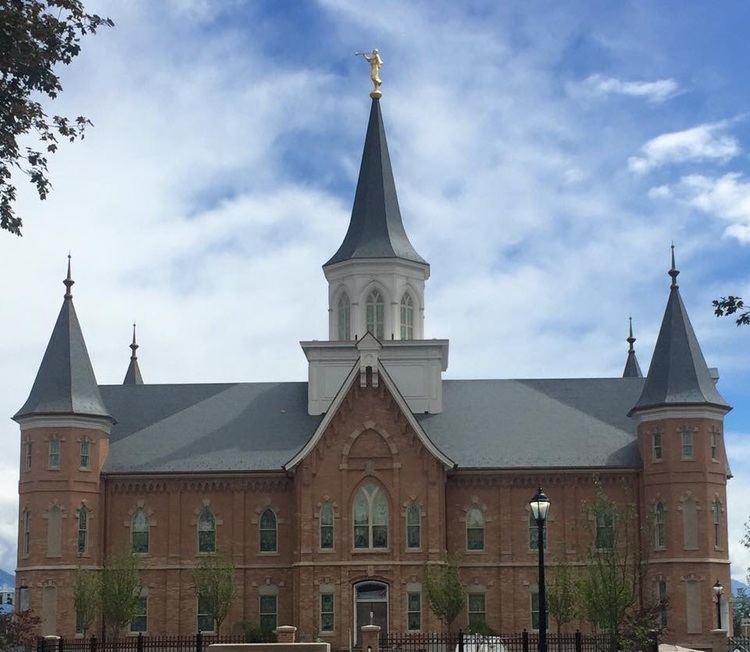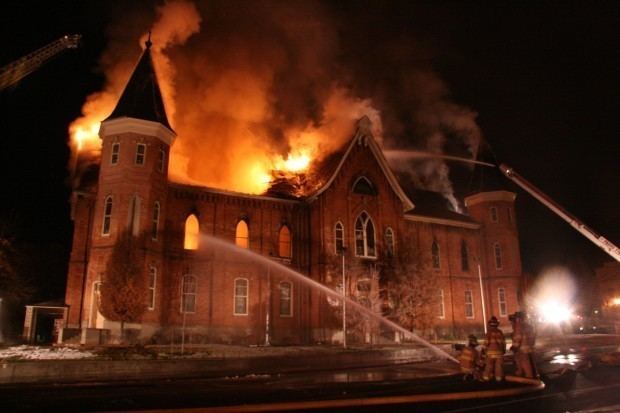Built 1883 Opened 6 April 1886 Added to NRHP 9 September 1975 | NRHP Reference # 75001830 Area 4,000 m² Architect William Harrison Folsom | |
 | ||
Similar Provo City Center Temple, Provo Utah Temple, Hotel Roberts, Maeser Elementary, Reed O Smoot House | ||
From tabernacle to temple provo s burned and ruined historic landmark restored
The Provo Tabernacle served as a tabernacle of The Church of Jesus Christ of Latter-day Saints (LDS Church) from 1898 to 2010 in downtown Provo, Utah, United States. It is a historic icon of Provo and has been home to many religious and cultural events. All but the outer walls of the building were destroyed by fire in December 2010. The LDS Church preserved the remaining outer walls and built a new foundation and interior as part of the Provo City Center Temple, completed in 2016.
Contents
- From tabernacle to temple provo s burned and ruined historic landmark restored
- April 2016 world report former provo tabernacle becomes church s 150th mormon temple
- First tabernacle in Provo
- Construction of the second tabernacle
- Cultural impact
- Fire
- Restoration
- References

April 2016 world report former provo tabernacle becomes church s 150th mormon temple
First tabernacle in Provo

Predating the existing Provo tabernacle was a smaller tabernacle (sometimes called the Old Provo Tabernacle) that stood from 1861-1919 on the same block, and was situated north of the current tabernacle building facing Center Street. Plans for the first tabernacle began as early as 1852, though ground wasn't broken until 1856. The Walker and Utah wars slowed the progress of building the original structure. Thomas Allman and John Watkins did much of the interior woodwork. The first tabernacle seated 1100, though more could fit with chairs added in the aisles. The single tower, located on the north end above the foyer, stood 80 feet (24 m) tall and carried a 500-pound (230 kg) bell. For practical purposes, the tabernacle was completed in 1861, although the final plastering and dedication of the building occurred in 1867. There is confusion as to whether Brigham Young or John Taylor dedicated the first tabernacle. At the dedication, Brigham Young expressed that the tabernacle was "entirely too small" and should have been completed 12 years previously. The original Provo tabernacle was razed between 1918-1919. The foundation for the first tabernacle and nearby baptismal font were unearthed by the Office of Public Archaeology at Brigham Young University in 2012. Many coins, trinkets and other small items that had fallen through the floor boards and remained in the foundation were discovered. The rock foundation was then disassembled and the stones were donated to Provo City.
Construction of the second tabernacle

The construction for the second and larger Provo tabernacle (referred to also as the Utah Stake Tabernacle or the New Provo Tabernacle) started in 1883. It was built by the LDS Church as a meeting place that would hold more people than its predecessor. The new tabernacle, designed by William Folsom could seat 3,000 individuals in its auditorium and balconies. The tabernacle was in use by 1886, when it held the church's general conference on April 6. Members of the First Presidency were in hiding at the time on polygamy charges and were not present. The tabernacle was dedicated on April 17, 1898, by George Q. Cannon, with church president Joseph F. Smith also in attendance. The building costs totaled USD$100,000. In 1907, a USD$10,000 organ from the Austin Organ Company was installed. In 1917, the cupola was removed due to the roof sagging.

In 1964, the tabernacle was updated, with much of the interior painted white, while the electrical and heating systems were updated.
Cultural impact

The Tabernacle was home to many concerts, LDS stake conferences, and other community events. One of the first big-name entertainers to perform in the tabernacle was Madame Abbie Carrington in 1891. On September 1, 1909, U.S. President William H. Taft visited and spoke in the tabernacle. In the 1930s, Herald R. Clark, the head of BYU's College of Commerce, arranged to use the tabernacle for university lyceum programs. One of the most famous lyceums occurred in 1938 when composer Sergei Rachmaninoff performed in concert. Many funerals of prominent residents of Provo were held in the tabernacle, including those of Abraham O. Smoot, Hugh Nibley and Truman Madsen. In 1975, the building was added to the U.S. National Register of Historic Places.
Fire
On December 17, 2010, at 2:43 AM MST, a four-alarm fire was reported at the tabernacle. Firefighters arrived to find smoke coming from the building. Firefighters initially believed they could save the roof and thus the outward structural integrity of the building, but at around 6:00 AM MST the roof collapsed. The fire continued to burn throughout the day.
On March 31, 2011, after 12 weeks of investigation, Provo City Fire Department released its findings and conclusion to the Provo Tabernacle Fire. The report states "The most probable proximate cause of the fire at the Tabernacle December 17, 2010 is a heat source, specifically an energized 300-watt lamp, which was placed too close to combustible materials, specifically a wooden speaker enclosure." The report also finds deficiencies with the lack of a fire protection system (including automatic sprinklers and notification system) and human error (including multiple failures to alert authorities of suspicious circumstances such as odor, correcting an unsafe condition, and failure to recognize and respond to the fire alarm).
According to press reports after the fire, a large painting of Jesus was found to have survived. All the figures including the background, with the exception of Jesus, in the painting were burnt by the fire. The figure of Jesus was surrounded by a clean, untouched area.
Restoration
On October 1, 2011, LDS Church president Thomas S. Monson announced in the semi-annual general conference that the Provo Tabernacle would be rebuilt to serve as a second temple in Provo. This will be the second city in the LDS Church to have two temples, following South Jordan, Utah which has the Jordan River and Oquirrh Mountain temples. It will be the second tabernacle in Utah to be converted to a temple, following the Vernal Utah Temple. The restoration will "include a complete restoration of the original exterior," and the artist's rendition in the press release includes the central tower from the original building. Construction reports in April 2013 showed the tabernacle on "stilts" as two basement levels are excavated and built beneath the remaining shell structure.
On June 9, 2015, the LDS Church announced that a public open house will be held from Friday, January 15, 2016 through Saturday, March 5, 2016, excluding Sundays. The temple was dedicated on Sunday, March 20, 2016.
